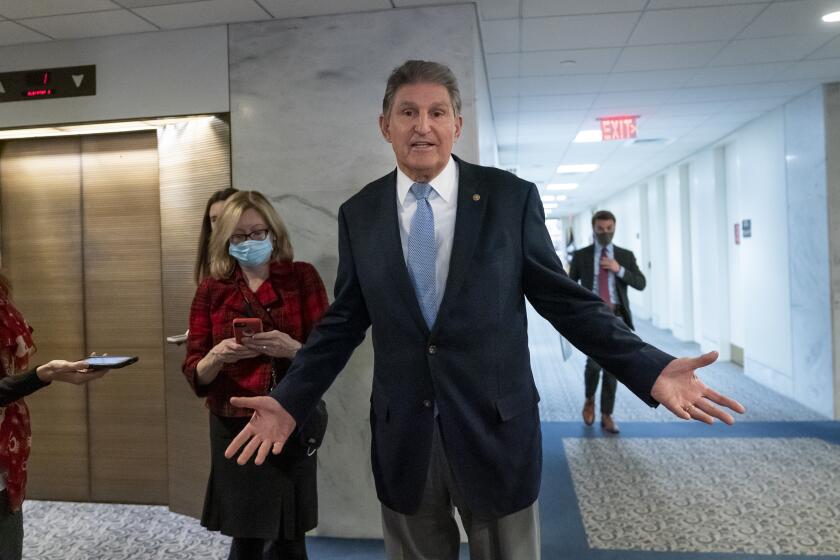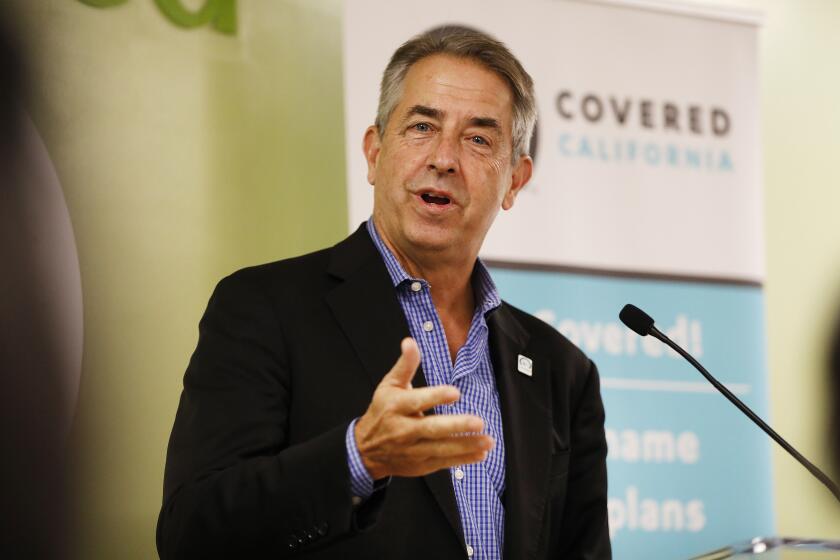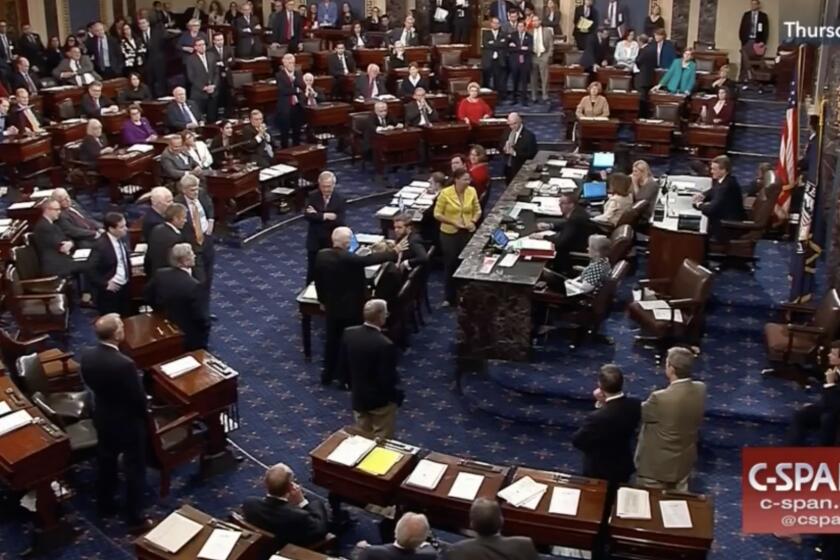Obamacare has been an economic boon, but some red states still don’t get the message

Every anniversary of Obamacare’s enactment is an occasion to take stock of the landmark legislation’s positive impact on Americans.
The latest — the 12th anniversary of its signing on March 23, 2010 — may have been the most important.
There are two main reasons. One is that the law proved its value more than ever during the pandemic, when it helped give millions of Americans access to crucial healthcare.
When you price people out of coverage, the people who drop coverage first are healthy people.... Everyone’s going to pay the price for that.
— Peter V. Lee, Covered California, on the impact of reduced ACA subsidies
The second is that the changes Congress made to the Affordable Care Act in the guise of pandemic relief are threatened with expiration at the end of this year.
Expiration would be a financial disaster for the families who benefit from those changes — which conformed with reforms that Democrats would have implemented in the ACA if they hadn’t been consistently blocked by congressional Republicans.
Get the latest from Michael Hiltzik
Commentary on economics and more from a Pulitzer Prize winner.
You may occasionally receive promotional content from the Los Angeles Times.
Then-Vice President Joe Biden notably told President Obama at the signing, in a remark picked up on a live microphone, that the law’s passage was a “BFD” (he didn’t use the initials, but no translation is necessary). Let’s take a look at what the ACA has meant to state and local governments and individuals over the years.
We can start with its expansion of Medicaid, which even before the ACA’s enactment was the nation’s largest government healthcare program.
Traditional Medicaid was directed chiefly at low-income households with children; the ACA expanded its reach to all those with income below 138% of the federal poverty level, which this year would be about $18,500 for an individual.
Chief Justice John Roberts, in his 2012 opinion upholding the ACA, turned Medicaid expansion into a state-level option. The fiscal implications were obvious: Under the ACA, the federal government would pay 100% of all costs in 2014, a share that inched down toward a permanent 90% in 2020 and after.
By Jan. 1, 2014, when the expansion began, only 24 states and the District of Columbia had opted in. Three more states joined over the next year. As of now, 12 states, all under Republican control, are still refusing.
Roberts’ decision, while stranding millions of Americans in the so-called coverage gap — ineligible not only for statutory ACA subsidies in the private market but for Medicaid coverage — did have the modest silver lining of creating a laboratory test of the fiscal impacts of expansion.
According to an analysis by Bloomberg, job growth in expansion states on average has outpaced that of Medicaid holdouts, especially during the recovery from the pandemic.
From April 2020 through January this year, Bloomberg’s Matthew Winkler reports, the number of U.S. jobs grew by 14.3% — 1.4 percentage points greater than the average among Medicaid holdouts and 0.6 of a percentage point less than the average for expansion states.
The expiration of the Child Tax Credit means 3.7 million more children in poverty. Is this the America we want?
Winkler pinpoints the two states at the opposite ends of the expansion spectrum. They’re Texas, which leads the nation with a medically uninsured rate of 18.4%, and Massachusetts, which has the lowest uninsured rate in the country, only 3%.
Employment in Texas has gained 13.6% since April 2020, Winkler reports — 1.3 percentage points less than the average among expansion states and nearly five points behind Massachusetts, where job growth reached 18.3% in the period.
The direct connection between job growth and Medicaid expansion and therefore a lower uninsured rate may be hard to identify, but it’s reasonable to assume that it has much to do with the economic benefits of a healthy workforce.
Other studies document how refusing Medicaid expansion has been not even penny-wise and just plain foolish. As the Commonwealth Fund observed in 2020, states pay between 25% and 50% of the cost of traditional Medicaid enrollees with the federal government picking up the rest, but only 10% of the cost of expansion members.
Because states have numerous options to offset expansion costs without harming beneficiaries, the net cost of expansion is negative — in other words, some states spend less on Medicaid even while covering hundreds of thousands more residents than they did before the ACA. From fiscal 2015 through 2019, the Commonwealth Fund reckoned, overall Medicaid spending increased by about 23%, but state spending didn’t budge at all.
One important point to remember about the ACA is that its critics have never made a coherent case against it.
The law can be faulted for not going far enough to relieve Americans of the burdens of our fragmented healthcare system, and as we’ve mentioned its subsidy structure can be improved through reform.
After 10 years in the ACA hot seat, Covered California boss Peter Lee looks back and ahead.
But it’s indisputable that the ACA brought health coverage to 20 million Americans who didn’t have it before; for most of them the available plans were indeed affordable, and in many cases free. The financial condition of hospitals that serve low-income communities was improved immeasurably.
None of the other nitpicks cited by critics, typically Republicans, hold water. They said the law would prevent consumers from choosing their own doctors or hospitals; in reality, those choices had been constrained by health insurance companies or employers for years and for almost all consumers, in a never-ending quest to control costs by fashioning narrow networks.
They said that the ACA would hasten the march toward single-payer healthcare. Two points about that. First, since single-payer is the most efficient and effective way to fund healthcare, what would be wrong with that? Second: If only. There are no indications that the prospects of single-payer healthcare have been affected at all by the advent of the ACA.
The most significant shortcomings of the ACA have been the product of Republican sabotage, which hit a peak during the Trump administration. Trump blocked cost sharing reduction payments to insurers, for example.
These payments were reimbursements for reductions to deductibles and co-pays the insurers were required to provide to low-income consumers by law; the blockage drove several community healthcare systems out of business. As legal experts predicted, federal courts eventually ruled that the government was obligated to make the payments, even if for some insurers the money came too late.
Another blow to the economics of the ACA — a “risk corridor” system that relieved insurers of the burden of covering particularly risky communities — was delivered by legislation pushed by Sen. Marco Rubio (R-Fla.), who has been inordinately proud of having harmed his own constituents with this stunt.
Alarmingly, Republicans have said that they will revive their efforts to “repeal and replace” the ACA if they regain full control of the federal government.
It should not be forgotten that in all the years that they voted to repeal the ACA, they never once put up a workable proposal to replace it — threatening to leave Americans exposed to higher costs and insurance denials for preexisting medical conditions.
Jonathan Cohn’s ‘Ten Year War’ is the definitive history of the Affordable Care Act.
As we’ve reported, expiration of the ACA subsidy increases would sharply raise coverage costs for households in the individual insurance market. The pandemic-era changes increased premium subsidies across the board and eliminated the “subsidy cliff” that cut off premium assistance entirely for those whose household income exceeded 400% of the federal poverty limit ($111,000 for a family of four this year).
Under the new system, no buyers would have to pay more than 8.5% of their income for a benchmark silver plan, regardless of their income.
“Fourteen million Americans will experience premium shock,” Peter V. Lee, the departing head of Covered California, the state’s ACA exchange, said earlier this month. Two million consumers might drop coverage because of its higher cost.
Covered California estimated that if the subsidies are returned to their previous levels, premiums for lower-income buyers would rise to $74 a month from zero. A middle-income couple in their early 60s “would lose all help and pay $1,720 more each month,” Lee said, potentially an insurmountable obstacle to maintaining coverage.
“The impact would be ongoing,” Lee said, because the risk profile of the ACA enrollment pool would deteriorate. “When you price people out of coverage, the people who drop coverage first are healthy people.... Everyone’s going to pay the price for that.”
President Biden has sought to extend the revised subsidies through the end of 2025 via his Build Back Better Act. But the act has been tied up in the Senate, due to the obdurate opposition of the entire GOP caucus and Sen. Joe Manchin III (D-W. Va.).
Cutting off the subsidies makes no sense whatsoever. The Congressional Budget Office estimates the cost of continuing the reforms at $220 billion over 10 years.
That’s couch change for the government — about one-third of 1% of all federal spending, which comes to some $6.6 trillion. But its yield in terms of better health for Americans, physically and financially, would be astronomical.
So let’s take this occasion to look back at what the ACA has brought us — and ahead to what it can still achieve.
More to Read
Get the latest from Michael Hiltzik
Commentary on economics and more from a Pulitzer Prize winner.
You may occasionally receive promotional content from the Los Angeles Times.














